Project Valiant: Reclaiming a Low-Mileage Car Driven by a Little Old Lady on Sundays
Updated Dec 3, 2013.
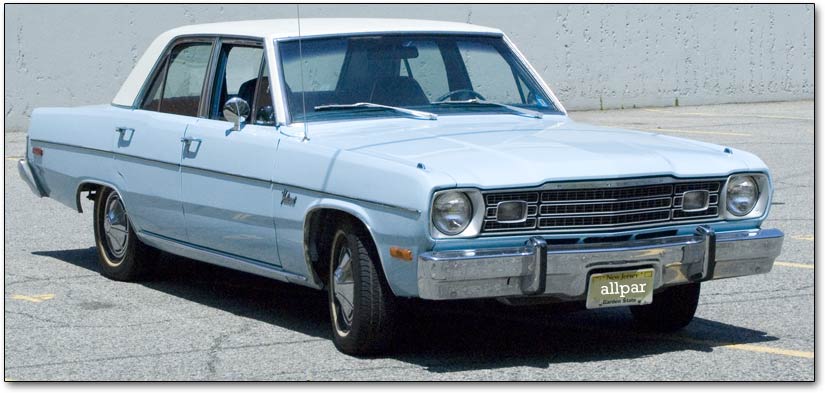
I heard about it when a lady asked (in the Valiant forums) about the value of her aunt’s car. We exchanged e-mails, I suggested $4,000 - $6,000 based on "book value" (Mannheim's Gold Book), and she ended up selling it to me for $1,000. The condition turned out to be rather different from “mint” and $1,000 was a fair-to-high price.
In less than 48 hours, Glenn Arlt at Hagerty had me insured so I could get a title and plates.
The 1974 Valiant made it home (232 miles) on July 20, 2005. We went to a town just north of Washington’s infamous beltway, and it started right up. It didn't want to go quickly and blew a little smoke when pushed over 60 mph (or going uphill). The engine went up to "almost overheating" and stayed there. The a/c was good though it could only be used now and then to avoid overheating. [A quick driveway tuneup later solved the overheating, smoking, and start-reluctance.]
On the way home, one of the snow tires, installed in the "F78" days, developed a huge bubble. Fortunately, we were just a mile from Exit 4 of the New Jersey Turnpike when the tire blew its bubble. BTS was one mile down and they had four new whitewall tires on in the space of two hours and $200, including new valves and balancing. That enabled me to get another 10 mph out of the Valiant, going from 55 to 60 uphill and 65 normal, keeping the engine load light to avoid overheating. While I cleaned out my garage, I stored the Valiant in a local storage facility.
One weekend, we rounded the corner, and there was a massively damaged door and broken pole on one garage...yes, it was mine. My lock had snapped in two, and the gate had come crashing down as some idiot in a truck had backed into it, breaking the concrete pole as well. Plastic fragments were everywhere. The following photo is from after they cleaned up the area:

There was no damage to the car. The Valiant later moved to a new storage unit, since they never got a new door up and relied instead on a great sheet of plastic to keep out the sun and rain.
I added a back door to my garage and put locks in, a bit ahead of schedule, moving the contents of the garage to a new shed; that was the end of the storage-unit days.
The brakes aren't terribly effective, albeit manual discs. Yes, I did have to slam them on, and yes, I did go into a diagonal skid for a brief and rather scary moment. I remember my old braking habits better now...including the swerve into the shoulder when all else failed.
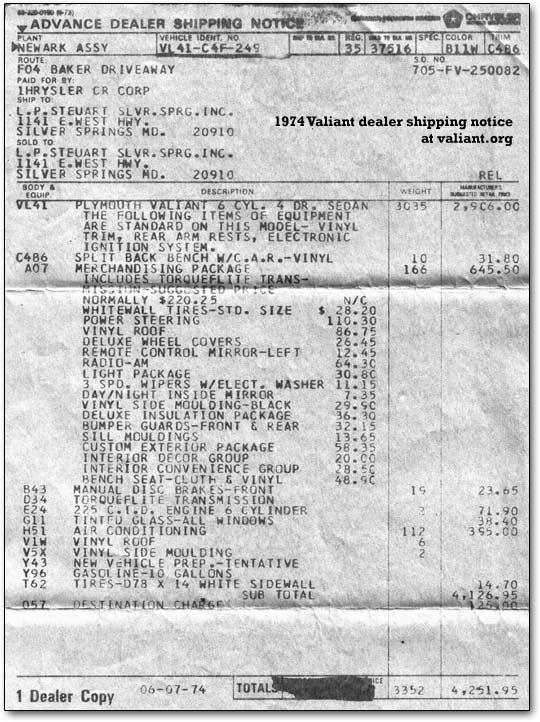
August 12, 2005
The Valiant fits snugly into the garage, with just enough room on the sides to get in and out. The air conditioning is still running strong, with no reciepts for a/c work in its long history. There’s some room in front for bikes. There is a thick layer of grime over many of the engine components, along with what appears to be a layer of fine sawdust over some of the engine bay. It must have been in a paint shop, many years ago; there are clear changes in the passenger-side door including an aftermarket mirror, incorrectly mounted in a spot far from where the stock mirrors are placed.
|
 |
The vacuum hoses are, shockingly, all in good shape; most of them are new. Mistakes in routing include an odd T which combined two vacuum sources, for no apparent reason, into the OSAC valve. The stove control had no vacuum at all! Once these were fixed, vacuum was strong and right in the middle of the green band on my gauge, with just a little fluctuation. But the Valiant pinged quite a bit under load, especially at highway speeds, and shows no desire to exceed 60-65 mph.
September 28, 2005
An oil change provided me with a chance to inspect the underside thoroughly, and everything is in decent shape. I dropped by a local body shop and got a quote on fixing the various dents and taking care of some surface rust developing along the bottom of the fenders - about $500 - $1,000, just repainting what has to be repainted and taking care of the various dents and cuts. For the moment all paint is original as far as I know.
I tuned the car using the vacuum-gauge method, and it runs far smoother than it did before. It did still have a problem with low power under load coupled with pinging, but that turned out to be a gas pump squirting fuel out instead of pumping it.
Even knowing what something should cost, do it yourself. I took the car to a mechanic because I didn't want to work with gasoline, told him it was the gas pump, said it was very accessible, and said the dealer wanted $20 for the pump. The bill came to $110. And mechanics wonder why they get a bad reputation... That didn't fix the pinging, though.
 |
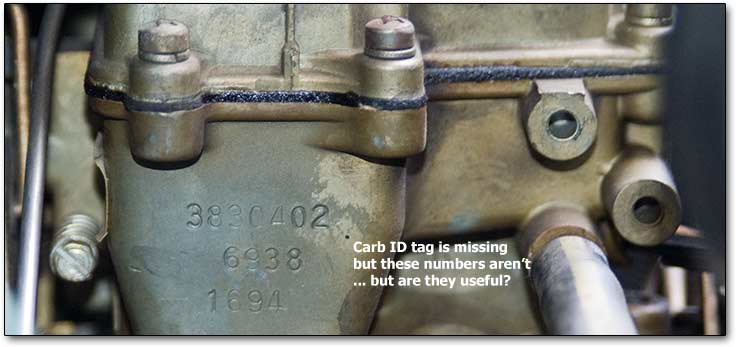 |
People really like the Valiant - some remember it as their first or second car, but even those who don't stop to stare and find it "cute" and "unusual." Imagine if it was an early Valiant with those distinctive Exner bodies! The robin's-egg-blue probably helps to make it look more presentable - that, and the lack of other A-bodies in the area. (Though there was a truly nice looking black 340 Duster parked down the street for a day or two, it doesn't engender quite the same feelings in bystanders!)
October 10, 2005: the first show
The Valiant went to its first car show, the Slant Six Club of New Jersey and New York’s annual picnic, in North Brunswick. It was the newest car there, and the one in the worst condition; every other car had an immaculate engine compartment, and none had dents or scrapes. Nobody mocked the condition of the car - though I have to admit I left the hood down most of the time, given the never-cleaned engine bay. (This is a “before” picture; the one you saw above was an “after” picture.)
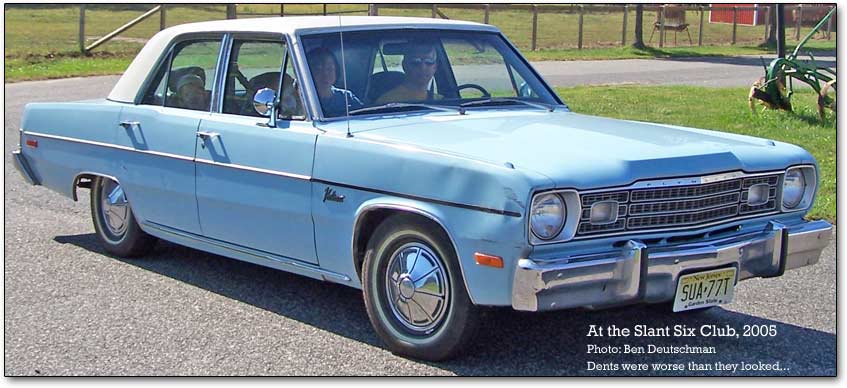
People were friendly and understanding - I showed up with my wife and two kids, aged 3 and 9, and they ran around but didn't touch or hurt any of the other cars. ... we showed up with one of those big tent things, but it had to be set up on the grass, not a parking lot; have to get one of those little portable folding things instead of one assembled with poles and stakes. It was a relatively intimate show, but there was a pretty good showing. (Yes, we did get a popup tent for future years, and attended this show every year till 2013.)
October 17: General update
I took another look at the timing, and found it to be 12 degrees off. I set the timing correctly, and suddenly, the pinging was gone, and the top speed seemed to jump upwards into firmly illegal territory. Hopefully this will improve the gas mileage, too, but I was starting to get concerned about the damage we were doing with the pinging.
I also changed a light bulb in the dash that had burned out. I remember now how much fun this was! Taking a work bulb with me (I used to use a flashlight in my teeth), I went upside-down under the dashboard, searching for the little hole. It turns out that the holder had fallen out, and that the bulb in the car was still good after all - so the previous mechanic hadn't done a great job of replacement. In any case, I eventually found the holder and the bulb, and put them in, knocking out the Fasten Seat Belts light as I did so. If you do it, be careful, because the fusebox is right there - disconnect the battery first!
Speaking of which, Jay, “68CudaPyro” from the forums, pointed out an easy way to get rid of the annoying seat belt safety interlock, which prevents starting the engine unless seat belts are fastened (in 1974 and some 1975 cars): “Look under the seats and locate the pressure switch. Unplug the connector. There you go.” That's a good tip. I always drive with the safety belt on, but I don't always want to fasten it just to pull the car out of the garage, and I also don't always want to fasten it before starting up. Sure enough, this worked instantly and relieved me of a lot of nuisance.

May 25, 2006
We got estimates from body shops to see how much it would cost to clean up the worst of the damage: Ricca (in Hackensack) and Garden State Auto Body (in Bergenfield). We had recommendations for Garden State and have used Ricca before for hit-and-runs. Both wanted just under $4,000 to do a complete job, knocking out dents and rust and repainting with modern clearcoat paint in the same color; Ricca also offered an 80% job for $2,000. In June, Carl Ricca offered to repaint the entire car for $2,450 to avoid using paint flattener; we agreed.
A thorough inspection from a mechanic at Teterboro Chrysler found that the rear leaf springs and shocks should probably be replaced (both are original), and discovered a transmission fluid leak coming from a driveshaft seal, which he fixed. He also banged the valve cover back into shape to stop oil leaks there - not a difficult job, he said, but one which I know better than to do myself.
July 4, 2006
We got the car back but it has to go back into the shop again because they left the aftermarket mirror on, since the new one didn't line up. They’re going to fill in the holes that some rather poor mechanic made, repaint, and then fit the reproduction mirror on so we can actually use it.
The difference between a $4,300 paint job and a $2,600 paint job (including dent and rust removal) is pretty clear when you look at the details: the door handles were masked off instead of removed, and there are a couple of other minor issues around hard-to-remove trim; and a couple of minor oversprays. However, the side strips, wheel-well trim, nameplates, etc. were indeed removed and replaced after painting. It still looks terrific with new-looking paint devoid of surface issues, drops, etc.
We then took the car to the local garage for new calipers in preparation for our long journey but in getting the calipers off, they pushed the ball joints over the edge, and now we need new ball joints. Rather than go one piece at a time, we're going to look at getting a complete new front suspension and doing everything at once.
The bad news is that with the ball joints in their current condition, we're going to postpone going to Carlisle in the Valiant, and will take the PT instead. The good news is that the rear drum brakes look new.

September 5, 2006
Carl Ricca of Ricca Auto Body in Hackensack, NJ did a bang-up job on the mirror - you can't tell the current mirror isn’t original and wasn't always there. He also supplied us with a big jar of leftover paint and the paint code in case we ever need it. Overall, he promised us the car would look “cherry” and that it does.
January 5, 2007
A heater hose started to leak at the firewall; we removed it, cut off the end, reattached it. A full hose replacement program seems to be called for before Carlisle. We also finally ran out of the original factory R-12 Freon and will have to get the system pumped up - hopefully there aren’t any leaks.
May 15, 2007
Getting the Valiant ready for its run, we took it to Gerard Automotive and found out that the hoses were all original; they are now all new. He also updated the refrigerant to the current less-useful neofreon. Here are some photos:
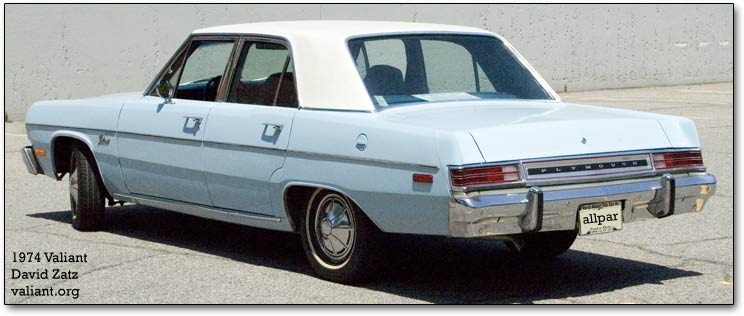
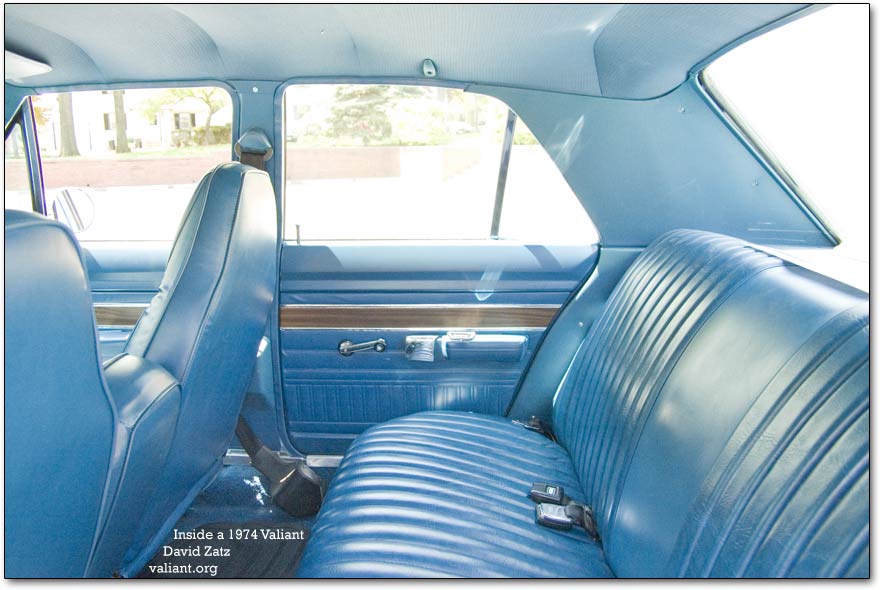
July 11, 2007
We took the Valiant to Carlisle, Pennsylvania, for the show, around 200 miles each way. The wipers suddenly stopped working - Bob O’Neill confirmed our belief that the linkage had broken, a cheap but somewhat difficult repair. We found that rain flies off the windshield effectively at speeds of 60 mph and higher, and according to other drivers’ reports, this actually worked better than modern wipers! We’re still going to fix them, we just got the parts for $5.
Power was quite good on the way up, with no problems with acceleration, and the air conditioning running the whole way with an overall 20 mpg (straight highway, normal highway speeds, passing frequently). Only rarely did we need to shut off the air - when making a particularly tough pass, and when sitting at traffic lights for long times.
On the way back, we filled with Pilot gas, foolishly leaving the cap on the fender and dropping it off somewhere in Carlisle. We got a locking gas cap to fill the hole but will have to buy a new used cap at some point and have it painted. The Pilot gas ran poorly and we had cut the a/c on long hills while listening to the fuel perculating. Idle quality fell quite a bit.
Bob O’Neill and the gang agreed that we could do with some more advance - we’re at top-dead-center now - and that the carb should be rebuilt and the float level very carefully adjusted. The car could run a lot leaner and could probably get another 4 mpg highway if set up well.
We did get the Allpar Voters’ Choice Award, nearly unanimously, but that was probably due to who owned the car as much as what it was. Still, it’s a very friendly looking car - not so perfect as to make people afraid to sit in (or drive) it, but still near new in appearance, with that nice baby-blue exterior; and nearly everyone either had one or knew someone who had one. That said, next year, our car won’t be entered in the competition!
Overall this was a successful run for the Valiant in its first major-show debut. Though it didn't win anything, it was the best four-door Valiant at the show, in our opinion - and one of just two, for that matter, out of literally dozens of Valiants and Dusters.
October 3, 2007
Our project Valiant was used as the test-bed for LED third brake lights (at allpar) and both LED bulbs and brighter tail-lights and sidelights (at allpar).

As part of the work we took out the back seat - easy enough to do: push the bottom cushion back towards the trunk and once it budges, lift up and out (that's the hard part). This reveals the bolts for the rear seatback; it also revealed the broadcast sheet, part of which had been torn away.

March 2008
We redid the wiring on our Valiant using Posi-Tap connectors. They work much better than standard splices and are very tough. This is important for brake wires...
The Valiant starts and idles very easily, but there’s often a smell of gas (though we did check for gas leaks, as did a qualified mechanic, and there are none); based on the gas mileage we’re thinking it’s time to rebuild the carb, and we’ll be doing that moderately soon. Daily driving is easy and there’s plenty of power for city driving, though getting onto highways without proper acceleration lanes is sometimes an issue. Cornering is decent enough for a car of this age and style.
We finally got the windshield wiper coupler we needed since the wipers stopped working on the way to Carlisle. It looks like this:

It’s not hard to put on: open the hood, remove the bolts that hold the wiper motor on, gently pull the wiper motor out (it is very heavy so be careful), and stick the coupler on, firmly, to the end of the shaft. The hard part is getting everything back together again, perfectly. There are probably lots of tricks for this. When we find one that works, we'll let you know.
I also had the Teterboro Chrysler mechanics take off the outer cover of the driver's side seat belt, since it sometimes locks up and absolutely refuses to release; they could not find anything wrong (but did know the trick to getting it off), but I figured that it's better to have no cover and be a little more careful around it, and still be able to manually release it if needed. I think now that either the screw or the cover itself was the problem, since it hasn't locked up since then; or maybe they did something to it; or maybe it’s just scared now because I can attack it with a screwdriver.
May 10, 2008
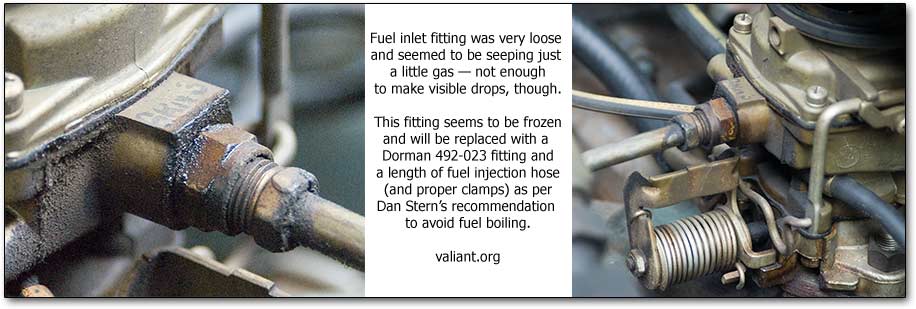
Okay, I'm officially giving up on getting the wiper motor to wiper arm linkage together. The coupler is simple, getting everything back together is impossible — for me.
I think I found the reason for my awful gas mileage — I haven’t caught it dropping gas, but the steel gas line into the carburetor was very loose and when I wiggled it, I thought I saw a little fluid glistening. I tighted it just around a quarter turn, enough to make it firm up, and think that should do it. I hope.
May 12, 2008
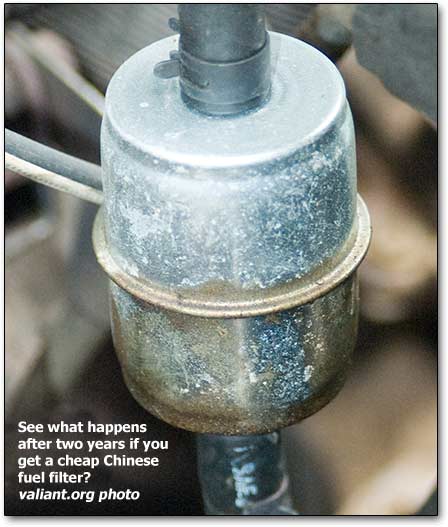 Now I found the real reason for my terrible mileage: it isn't that bad. I got the tank refilled and though it showed more than half empty, it took just 5.6 gallons, which brought me to a respectable 14.8 city miles per gallon. After tightening the gas line where it went into the carburetor and leaning out the carb idle by one quarter turn, which had no apparent effect, I think I might have helped the next fill to go over 15. Maybe. I’ll be replacing the fitting entirely.
Now I found the real reason for my terrible mileage: it isn't that bad. I got the tank refilled and though it showed more than half empty, it took just 5.6 gallons, which brought me to a respectable 14.8 city miles per gallon. After tightening the gas line where it went into the carburetor and leaning out the carb idle by one quarter turn, which had no apparent effect, I think I might have helped the next fill to go over 15. Maybe. I’ll be replacing the fitting entirely.
I’m also replacing the fuel filter already — not because it needs it, but because it looks as though the current fuel filter has been leaking around the seam. It’s hard to say but I don't want to take a chance, and as previously noted I'm replacing the metal fuel line that goes from the filter to the carburetor anyway. Dan Stern recommend replacing all the metal fuel line, but for the moment I'm planning just to change the short length that goes between the carburetor and the fuel filter, partly to prevent fuel boiling on top of the manifold, and partly because the current placement seems fairly sensible (and might not be factory stock).
June 3, 2008
I replaced the spark plug tube gaskets — and have photos over at allpar. See replacing slant six spark plug tube gaskets.
December 28, 2008
There isn’t much to report. For various reasons, I have not done much with the car other than drive it and reduce the fast idle and lean out the carburetor a little, the latter based on gas mileage. It runs better now; maybe I tuned it on the rich side because of lower fuel pressure from all the leaks? In any case, this is the best-running classic car I’ve ever owned, period. Quiet, no bogging (okay, not much power by V8 standards, either), and it always starts right up (except when warm, it sometimes gets a touch of vapor lock.)
Two people volunteered solutions for the speedometer tick (which seems to have cured itself) and the windshield wiper linkage (which hasn’t.)
That’s all for the moment.
July 3, 2009
Thanks, Scott, for doing most of the work on fixing the windshield wiper linkages. To the rest of you, here are the tricks we learned:
1) If you have air conditioning, remove the glove compartment box (and, if you can, the door); the ash tray and its housing; and your radio first. Otherwise, you won't be able to do much.
2) The wiper arms have to come off and they have a funny latch mechanism which must be disengaged while the arms are pulled up; then they lift right off. When you put them back on, they have to be dropped back down onto the glass... you may not get the positioning right the first few times.
3) Get at least four of the plastic links and replace them all.
4) A kit used to be available from Schumaker with grease fittings (these can be essential if the reason for the link failure is a high-friction pivot), new water seals, and instructions. These kits are essential to leakproofing the Valiant.
5) You will need a light down there. I suggest a compact fluorescent in a standard housing because you won’t burn yourself on it. You may, however, still poke your eyes out on the bolts that hold the a/c vents on, so WEAR GOGGLES. That will also protect you from a trip to the hospital with fiberglass particles in your eyes.
6) Use duct tape to get all the sound insulation firmly mounted where it belongs, or tear it out, because otherwise your wiper links will rub up against it and tear it apart.
7) Once the linkages are back in, make sure they are not rubbing any wires with those razor-sharp edges.
July 5, 2009
To get rid of the smell of smoke that pervades the car, we have finally taken out the carpet and tried to clean it.
April 26, 2011
There’s been an air conditioner refrigerant leak and it’s been getting worse, that needs to be addressed. However, the third brake light has given no trouble. I've thought of getting an FM radio but original period radios run $100 “don’t know if it works” so that will probably not happen. There are good aftermarket stereos in original cases at a price, but that’s a pretty high price.
Got new tires today — went to 195/70 size General Altimax and it looks fine and natural. They’re a little smaller than the stock D78 but the 195/75 is a bit larger, so it works out. The tires no longer have that “bulging around the wheel” look, which should help stability.
The carpet cleaning worked out pretty well; there’s still the smell of burnt oil and transmission fluid. The oil has remained stubbornly full despite various leaks; the transmission fluid’s definitely leaking, but very slowly, around one pint per year. It needs to be addressed, though.
December 3, 2013
This is a long delayed update.
First, the smell of smoke from the carpet is long gone, which is nice, along with the smell of oil and transmission fluid. Part of this is due to a little more work by Teterboro Chrysler on those leaks, still quite minor in scope but apparently spread across the car. The loss is well under one quart of oil and one pint of transmission fluid per year.
I swapped out the upper and lower radiator hoses, and the slight antifreeze leak seems to have stopped. There is one spot on top of the radiator that turns into a pinhole leak under high heat conditions, but I haven’t encountered those since taking the car to Carlisle, Pennsylvania.
The air conditioner refrigerant leak was addressed by a mechanic at Teterboro Chrysler. He dis-assembled the entire system, changed the oil in the compressor (mostly to get the proportions right), and checked every seal. The original mechanic at Gerard Automotive had apparently left half the original gaskets in, though there was no reason to — the kit comes with enough new gaskets for a proper conversion. That explains the endemic leaks. The Teterboro mechanic was unable to find any serious leaks once the new gaskets and seals were in place, and so far the system has survived a year without a new charge.
Projects still left undone:
- Daniel Stern’s excellent headlight fix (using relays)
- Rick Ehrenberg’s alternator gauge bypass
- Daniel Stern’s evaporator-temperature a/c control system modification
- Daniel Stern’s amber-turn-signals modification


 Your Privacy Choices
Your Privacy Choices